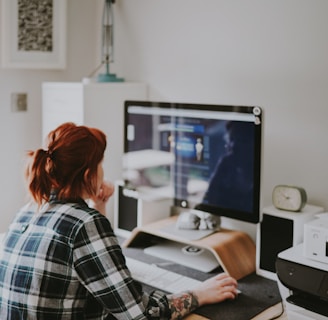
Is Working From Home Secretly Aging You? The Truth About Indoor Sun Damage
* This post contains affiliate links. If you click through and make a purchase, I may earn a small commission at no extra cost to you. Thank you for supporting The Remote Mom HQ!
Table of Contents:
Introduction
1. Window Woes: How UV Rays Sneak Indoors
2. Screen Time & Blue Light: The Indoor Skin Agers
3. Skin Health Matters: Don’t Wait for Signs of Aging
4. Choosing the Best Indoor SPF: What to Look For
5. Building SPF into Your Routine (and Sticking to It!)
Conclusion
Introduction
If you’ve ever thought, “I’m inside, why would I need sunscreen?” you’re not alone! But while working from home, many of us forget that UV rays don’t stop at the window. From sunny home offices to time spent near windows or screens, our skin faces surprising risks indoors. Let’s dive into why indoor sun protection is a must for remote workers and how a quick layer of SPF can save your skin in the long run.
1. Window Woes: How UV Rays Sneak Indoors
First things first, those rays coming through your windows? They’re not as innocent as they seem. UVA rays—known for penetrating deeply into the skin—easily pass through glass and can accelerate aging and skin damage. In contrast to UVB rays, which cause sunburn and can be blocked by windows, UVA are able to sneak through, causing wrinkles, fine lines, and those pesky dark spots that seem to appear out of nowhere.


Think of the times you sit by a sunny window or even when your desk faces a bright view. UVA exposure adds up, and without SPF, your skin is unprotected. So, before you scoff at putting on sunscreen indoors, remember those sneaky rays—especially if you spend hours near a window.
Pro Tip: If you want a little extra assurance, try adding a sheer curtain or UV-blocking window film to your windows. It won’t replace SPF but can add an extra layer of protection.
2. Screen Time & Blue Light: The Indoor Skin Agers
You might think that if you stay away from windows, you’re safe. But digital screens emit blue light, a high-energy visible (HEV) light that penetrates deeply into the skin, much like UVA rays. This exposure has been shown to accelerate skin aging, leading to hyperpigmentation and reducing skin elasticity. If you’re spending hours glued to your computer or phone, your skin might be taking a hit without you realizing it.


The good news? Some sunscreens now protect against blue light as well as UV rays. Many SPF formulas designed for indoor use even come with antioxidants to fight damage caused by HEV light. And remember, blue light isn’t just a daytime thing—if you’re scrolling late at night, your skin’s exposure is only increasing.
Pro Tip: Look for sunscreens that list “blue light protection” on the label, or physical sunscreens with Zinc Oxide like blk Cosmetics mineral sunscreen primer stick SPF50. And, if your screen time is through the roof, consider adding an anti-glare screen protector—it reduces glare and minimizes blue light exposure.
3. Skin Health Matters: Don’t Wait for Signs of Aging
Sun damage isn’t just about wrinkles and dark spots; it can lead to serious conditions like skin cancer. Though UVB rays cause immediate sunburn, UVA exposure quietly damages skin cells beneath the surface. Indoor exposure, while lower than direct sunlight, can cause gradual damage over time.


One case study revealed that people who spend long hours by windows or in well-lit indoor areas can experience visible skin changes within months. Remote workers, who often stay near windows without realizing the risk, may see early signs of aging even if they’ve never considered themselves “sun lovers.” By incorporating SPF into your morning routine, you’re taking a small but impactful step toward long-term skin health.
4. Choosing the Best Indoor SPF: What to Look For
So, what’s the best sunscreen to wear indoors? Look for a broad-spectrum SPF 30 or higher, which blocks both UVA and UVB rays. For indoor use, you may want a lightweight, non-greasy formula that feels comfortable all day. Tinted sunscreens are also popular—they add a touch of color, even out skin tone, and often contain iron oxides, which further help to block blue light.


Here are some great options:
SPF 30 or higher: This is the standard recommendation for daily use indoors.
Lightweight, non-greasy formulas: Keep it comfortable since you’ll likely wear it all day.
Tinted sunscreens: These provide both SPF protection and light coverage, perfect for Zoom calls.
SPFs with antioxidants: Ingredients like vitamin C or niacinamide can help counteract blue light damage.
Tip: Apply SPF to your face, neck, and hands. We often forget our hands and neck, I know I do, but these areas show signs of aging just as fast as our face.
5. Building SPF into Your Routine (and Sticking to It!)
The challenge of an indoor SPF routine is getting it to feel automatic. Try making sunscreen part of your morning routine, just like brushing your teeth. Put it somewhere visible so you’re reminded every morning. And, if you’re skeptical about how much of a difference SPF can make indoors, start small. You’ll soon notice that even minor skin imperfections or uneven tones start to improve.


Tip: Many find tinted sunscreen easier to use daily since it doubles as a foundation or light base. Experiment with a few brands until you find one you like—you’ll be more likely to stick with it.
Remember, skin care doesn’t have to be all or nothing. Even if you miss a day, getting back on track the next morning keeps you moving in the right direction.
Conclusion
The bottom line? Just because you’re indoors doesn’t mean you’re safe from sun damage. Between sneaky UVA rays, blue light from screens, and the cumulative effects of daily exposure, our skin could use a little extra protection, even if we’re working from the comfort of home.
By choosing a good indoor SPF, you’re making a small daily commitment to keeping your skin healthy, youthful, and resilient.
So tomorrow morning, when you’re grabbing your coffee and laptop, take an extra second to reach for the SPF, too. You’ll thank yourself down the road, and so will your skin!
Thrive Remotely, Live Fully. ✨
